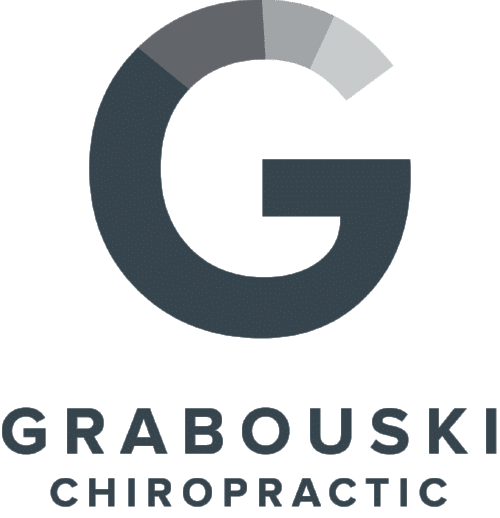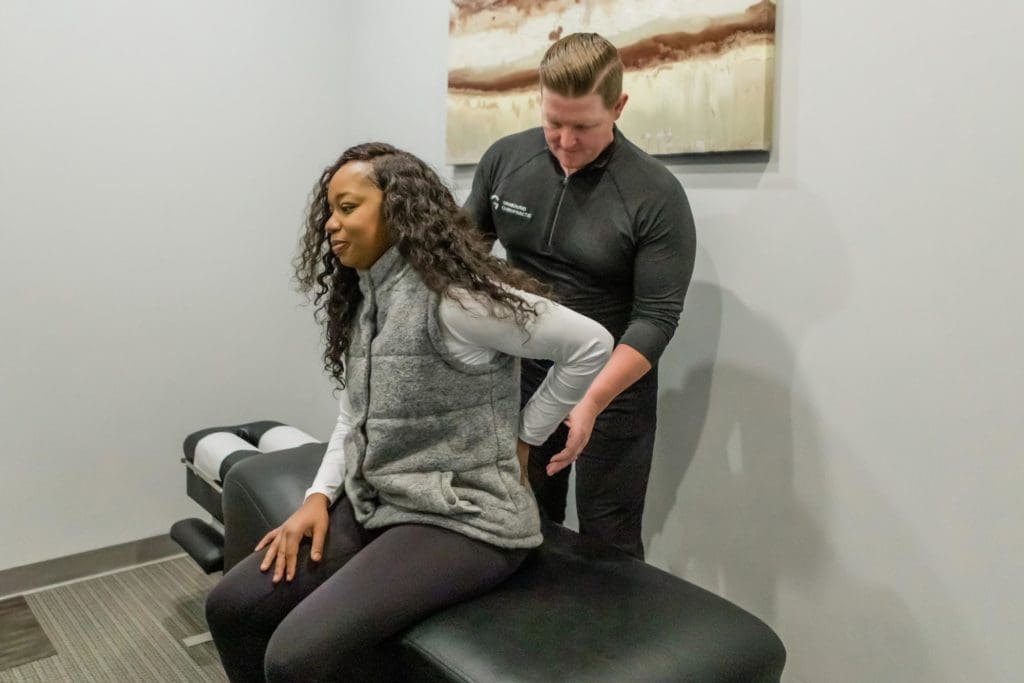What Is a Pinched Nerve?
The spine is made up of 33 bones called vertebrae and divided into four regions: cervical (neck), thoracic (mid back), lumbar (lower back), and sacrum. The vertebrae surround the spinal cord, a thick band of nerve tissue that runs through the spine, providing 360o of protection. Each vertebral body has openings called foramen for nerves branching off the spinal cord to exit the spine and run to the hands, legs, torso, and other locations in the body. Pinched nerve is an umbrella term for any spinal condition that compresses nerves exiting the spine and causes symptoms in the region that particular spinal nerve exits to. This can include structural problems like disc herniation, spondylolisthesis, and disc degeneration or the formation of bone spurs, and more. These problems can cause pressure leading to symptoms below.
Cervical Pinched Nerve (Neck)
Spinal nerves that exit in the cervical region are directly involved in the function of the shoulders, arms, and hands, meaning that pinched nerves in this region will create symptoms in those locations. Typically, symptoms from a pinched nerve will only produce symptoms that occur on one side of the body. Symptoms usually manifest as a sharp shooting or throbbing pain, numbness, tingling, or decreased sensation. Pain is experienced in the body part that the pinched nerve is involved in the function of. For example, weakness in the deltoid muscle while raising your arms from your sides could indicate a pinched nerve at the C4-5 level. Other potentially affected muscles include the bicep, triceps, wrist, and hand muscles.
- C4-C5 Pinched Nerve: The C5 nerve root is responsible for the deltoid muscle which sits on top of the shoulder, outside of the upper arm. A pinched nerve at the C4-5 level would cause shoulder pain and possibly weakness of the deltoid muscle.
- C5-C6 Pinched Nerve: The C6 nerve root is responsible for the bicep and wrist extensor muscles. The bicep bends the elbow and the wrist extensors allow for pulling the wrist back to put the palm up. A pinched nerve may cause weakness at one or both muscles groups with pain that may radiate down the thumb side of the arm.
- C6-7 Pinched Nerve: The C7 nerve root is responsible for the triceps and flexors of the wrist. The triceps straighten the elbow and the wrist flexors bend the wrist to bring the hand closer to the forearm. A pinched nerve may cause weakness at one or both muscle groups. Pain may radiate down the back of the arm and into the middle finger.
- C7-T1 Pinched Nerve: The C8 nerve root is responsible for flexion of the fingers, such as with making a fist. A pinched nerve may cause a weakened grip with pain that radiates into the pinky side of the arm.
Localized pain symptoms from a pinched nerve may include neck pain, neck stiffness, decreased range of motion in the neck, and headaches.
Thoracic Pinched Nerve (Mid Back)
The spinal nerves from the thoracic spine are involved with the function of the chest and abdomen. The exception is with the first thoracic nerve, which is also responsible for the ring and pinky fingers. A pinched nerve at the thoracic levels may cause pain and/or numbness in the back, chest, abdomen, and/or the ring and pinky finger. The nerves from the thoracic spine run directly above each rib. These nerves supply sensation to the torso and motor strength to the intercostal and abdominal muscles. Symptoms of pinched nerves typically unilateral, or only occurring on one side of the body.
- T1-T2 Pinched Nerve: The T1 spinal nerve is responsible for the ring and pinky fingers and the area at the first rib. A pinched nerve may cause pain in the back or chest at the first rib, or pain in the ring and/or pinky fingers.
- T2-T6 Pinched Nerve: The T2 through T6 spinal nerves are responsible for the intercostal muscles and skin on the thorax, corresponding to the rib that it is numbered. A pinched nerve may cause pain in the back or chest at the corresponding rib.
- T7-T12 Pinched Nerve: The T7 through T11 spinal nerves are responsible for the intercostal muscles of the corresponding rib, skin on the thorax, and the abdominal muscles. A pinched nerve may cause pain in the back, chest, or abdomen.
- T12-L1 Pinched Nerve: The T12 spinal nerves are responsible for the abdominal muscles and the skin over the buttocks. A pinched nerve at this level may cause pain into the buttocks or over the abdomen.
Localized symptoms of pinched nerve in the thoracic spine may include pain or stiffness of the midback. As there is little range of motion in this portion of the spine, no changes in range of motion would be noticed.
Lumbar Pinched Nerve (Lower Back)
Spinal nerves that branch out of the lumbar spine control function in the lower extremities (buttocks, hips, legs, and feet). Therefore, a herniated disc causing nerve compression in this region will produce symptoms in the lower extremities including a sharp, shooting, burning, or electrical pain and potentially numbness or changes in sensation. For example, weakness while straightening the leg could indicate a pinched nerve at the L3-4 level. Other potentially affected muscles include the quadriceps, tibialis anterior, and flexors of the foot. Symptoms may also include neurogenic claudication, a nerve-related pain that increases with walking and improves with rest. These typically occur unilaterally, only on one side of the body, and the specific location of the symptom will vary based on the nerve being compressed.
- L1-L2 Pinched Nerve: The L1 spinal nerve root is responsible for the psoas muscle, which is found within the body cavity along the lumbar spine. Weakness in the psoas muscle and pain in the groin and front of the thigh may occur; the former can cause difficulty with lifting the leg, for example, while walking up starts.
- L2-L3 Herniation: The L2 nerve root is responsible for the iliopsoas muscles. A disc herniation at this level may cause weakness in an iliopsoas muscle, which may cause difficulty while walking up the stairs and/or pain that radiates into the front of the thigh.
- L3-L4 Pinched Nerve: The L3 nerve root is responsible for the quadriceps femoris muscles, located on the front of the thigh and helps extend, or straighten, the knee. A pinched nerve may cause weakness of quadriceps femoris, which may cause weakness while straightening the leg and/or pain in buttocks that radiates to the lower portion of the front of the thigh.
- L4-L5 Pinched Nerve: The L4 nerve root is also responsible for the quadriceps femoris muscles and in some people, is also responsible for the tibialis anterior muscle. The quadriceps femoris straightens the knee and the tibialis anterior brings the toes up while walking. A pinched nerve may cause weakness while straightening the knee or lifting the toes when walking, which may lead to a foot drop. Pain may radiate from the buttock to the top of the back of the thigh and then to the front of the shin.
- L5-S1 Pinched Nerve: The L5 nerve root is responsible for the tibialis anterior muscle in most people and foot and toe dorsiflexion. The tibilais anterior brings the toes up toward the face and foot and toe dorsiflexion brings the foot toward the face. Pain may radiate from the buttock, down the back of the thigh and calf, and into the foot, mainly on the inside of the foot.
- S1 Pinched Nerve: The S1 nerve root exits below the S1 vertebral body, which is responsible for calf muscles, which allow for plantar flexion, or pressing down like on the gas pedal in the car. A pinched nerve may cause weakness with plantar flexion which could cause difficulty or inability to stand on toes and pain that may radiate from the buttock down the back of the leg and into the bottom of the foot’s outside edge.
The main symptoms of a pinched nerve radiate based on the location of the pinched nerve. There are other symptoms such as localized lower back pain, decreased range of motion in the lumbar spine, and limping or difficulty walking. An emergent spinal condition found only in the lumbar spine is cauda equina syndrome. The spinal cord ends around the T12-L2 vertebral bodies in a collection of nerves called the cauda equina, which is like a horsetail. If a pinched nerve places pressure on the cauda equina, this produces a large amount of inflammation around these nerves and distinct symptoms which include saddle anesthesia (numbness in the perineal regions, the region that would make contact when sitting in a saddle), bowel and/or bladder incontinence, weakness in the legs, and unsteadiness with walking. This is a rare condition, but is serious and needs emergent attention to prevent irreversible damage to the nerves.
Pinched Nerve Treatment With Chiropractic Care
Once a pinched nerve is diagnosed through history, physical exam, and imaging studies, a treatment plan is created. Treatment generally begins with addressing symptoms through conservative, non-invasive chiropractic care. Dr. Grabouski is well versed with the spinal cord and its functioning, and can help reduce the tension and pressure on the nerves through a gentle chiropractic adjustment. This results in the freeing of the compression and can help heal the compressed nerve.
If you’re in pain, it’s time to get to the root cause. Schedule an appointment today in our Overland Park chiropractic clinic!


